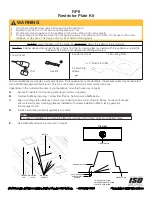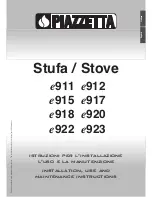
7
AIR FOR COMBUSTION AND VENTILATION
WARNING:
This heater should not be installed in a confined space or unusually tight construction unless
provisions are provided for adequate combustion and ventilation air. Read the following instructions to insure
proper fresh air for this and other fuel-burning appliances in your home.
PRODUCING ADEQUATE VENTILATION
This heater shall not be installed in a room or space unless the required volume of indoor combustion air is provided by
the method described in the NATIONAL FUEL GAS CODE, ANSI Z223.1/NFPA 54, the INTERNATIONAL FUEL GAS
CODE, or applicable local codes.
The following are excerpts from National Fuel Gas Code, ANSI Z223.1/ NFPA 54, Air for Combustion and Ventilation.
All spaces in homes fall into one of the three following ventilation classifications:
1. Unusually Tight Construction
2. Unconfined Space
3. Confined Space
The information on pages 7 through 9 will help you classify your space and provide adequate ventilation.
Confined and Unconfined Space
The National Fuel Gas Code
, ANSI Z223.1 defines a confined space as a space whose volume is less than 50 cubic
feet per 1,000 BTU per hour (4.8 cubic meters per kw) of the aggregate input rating of all appliances installed in that
space and an unconfining space as a space whose volume is not less than 50 cubic feet per 1,000 BTU per hour (4.8
cubic meters per kw) of the aggregate input rating of all appliances installed in that space. Rooms communicating
directly with the space in which the appliances are installed*, through openings not furnished with doors, are
considered a part of the unconfined space.
This heater shall not be installed in a confined space or unusually tight construction unless provisions are provided for
adequate combustion and ventilation air.
·
Adjoining rooms are connecting only if there are doorless passageways or ventilation grills between them
Unusually Tight Construction
The air that leaks around doors and windows may provide enough fresh air for combustion and ventilation. However,
in buildings of unusually tight construction, you must provide additional fresh air.
Unusually tight construction is defined as construction where:
a) walls and ceilings exposed to the outside atmosphere have a continuous water vapor retarder with a rating of one
perm (6x10
-11
kg per pa-sec-m
2
) or less with openings gasketed or sealed
and
b) weather stripping has been added on windows that can be opened and on doors
and
c) caulking or sealants are applied to areas such as joints around window and door frames, between sole plates and
floors, between wall-ceiling joints, between wall panels, at penetrations for plumbing, electrical, and gas lines, and
at other openings.
If your home meets all of the three criteria above, you must provide additional fresh air. See
“
Ventilation Air from
Outdoors
”
(page 9). If your home does not meet all of the three criteria above, proceed to
“
Determining Fresh-Air Flow
for Heater Location:
Содержание BD23TCC-2-LO
Страница 27: ...27 Printed in China...








































